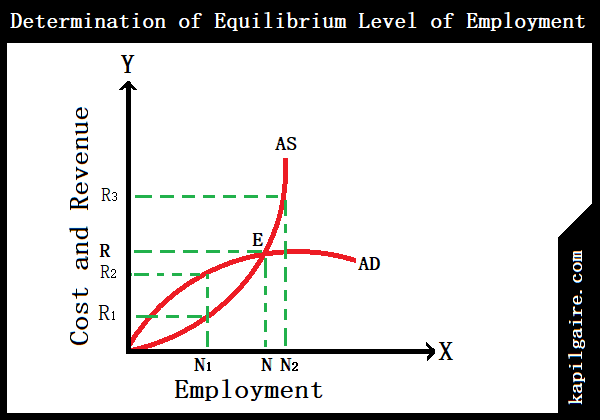J.M. Keynes was the first to develop a systematic theory of employment in his book "The General Theory of Employment, Interest and Money" published in 1936. Keynesian theory of employment is also called the "Effective Demand Theory of Employment" or "Principle of Effective Demand". According to this theory, the cause of unemployment is the deficiency of effective demand and method to solve the unemployment problem is to raise effective demand.
Table of Contents
Assumptions:
- Keynes confines (limit) his analysis to the short-period.
- There is perfect competition in the market.
- Presence of closed economy ignores the effect of foreign trade.
- It deals with only with aggregate macroeconomic variables.
- The labor has money illusion. (It means that workers feel better when wage rate increases even when there is an increase in price).
According to Keynes, effective demand is determined by the following factors:
1. Aggregate Demand Function (ADF):
Aggregate demand function is the relationship between the various level of employment and the expected in from the sale of output. The expected income from such different level of employment is called aggregate demand price. (ADP) for the output.
3. Aggregate Supply Function (ASF):
Aggregate supply function is the relationship between the various level of employment and the amount of money that entrepreneur must get from the sale of output. In other words, it represents different levels of income which the entrepreneur will supply at different levels of employment.
Determination of equilibrium level of employment by the principle of effective demand
Effective demand is the point when ADF and ASD intersect with each other. According to Keynesian theory, the equilibrium level of employment is determined at the point of intersection between aggregate demand function and aggregate supply function. The determination of the equilibrium level of employment is shown in the figure below:In the figure above, AD and AS represents aggregate demand and aggregate supply respectively. These two curves are intersecting at point E which is the point of effective demand. Aggregate supply represents cost while aggregate demand represents expected receipts of the entrepreneurs. As long as receipts are greater than costs, the employment will continue to rise. This process will continue till receipts become equal to costs. No employment will be offered if costs are greater than receipts. ON is the equilibrium level of employment. At this level, aggregate demand (expected receipts) is equal to aggregate supply (cost). At ON level of employment, the entrepreneurs will maximize their profit and will not have the tendency to increase or decrease in employment. At ON1 level of employment, the expected receipts are greater than the costs. This will induce to increase employment level. At employment level ON2, the cost is greater than expected receipts. Such a level of employment will not be offered, because it will involve losses.
The level of employment as represented by the point of effective demand (point E) does not necessarily indicate a full employment equilibrium. Keynes argues that full employment is not possible in the capitalist economic system. This is the normal situation in the economy. From the diagram above, it is clear that there exists an NN2 level of unemployment at E point of effective demand. It is because investment is inadequate to fill the gap between income and consumption.
Criticism of Keynesian Theory
- Not a complete theory: The Keynesian theory is not a complete theory of employment because it does not provide any comprehensive treaments or remedies of unemployment. It deals only with cyclical unemployment and ignores other forms of unemployment, such as frictional unemployment, technological unemployment, etc. It does not tell us how to achieve full and fair employment.
- Based on the unrealistic assumption of perfect competition: Keynesian theory of employment is based on the assumption of perfect competition but this is not a very realistic assumption. He completely ignores the problem of monopoly and other imperfect competitions.
- No direct relationship between unemployment level and effective demand: There exists no direct relationship between effective demand and volume of emploment. It depends upon the relationship between wage rate, price and money supply.
- Short-run analysis: Keynesian theory deals with short-run phenomenon paying no attention to the long-run problems of the dynamic economics.
- Ignore microeconomic problems: The Keynesian theory is the perfectly macroeconomic theory. It deals only with aggregates. It completely ignores microeconomic problems.
- Assumption of closed economy: Keynes assumed closed economy. In this way, he completely ignores the impact of international trade on growth of employment and income of the economy.
- Capitalist theory: The Keynesian theory is a capitalistic theory. It examines the determinants of unemployment in a free enterprises economy. However, Keynes has suggested government intervention and controlled capitalism. This theory fails to deal with the inflationaly (condition of rising in the price level) situation.




